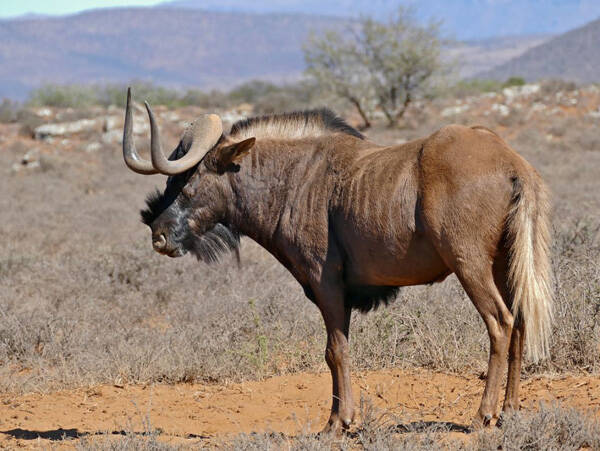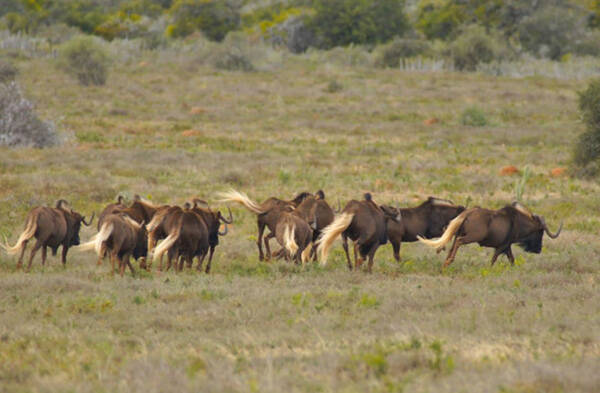Connochaetes gnou
IUCN
LCBasic Information
Scientific classification
- name:Connochaetes gnou
- Scientific Name:Connochaetes gnou,Black Wildebeest, White-tailed Gnu
- Outline:Ungulata
- Family:Artiodactyla Bovidae Connochaetes
Vital signs
- length:About 2 meters
- Weight:57-110kg
- lifetime:About 20 years
Feature
The mane stands up from the neck, the horns are stretched forward, and the tail is white.
Distribution and Habitat
Origin: South Africa.
Introduction: Botswana; Namibia.
Reintroduction: Slovenia and Lesotho.
The white-tailed wildebeest is a selective short-grass grazer inhabiting open plain grasslands and Karoo scrubland in South Africa and Lesotho, high and central highland grasslands characterized by flat to rolling plains, and mountainous areas at altitudes between 1,350-2,150 meters. Originally, the white-tailed wildebeest inhabited high cold temperate grasslands during the dry winters and the dry tablelands of southern Africa during the rainy season. However, due to leather hunting in the 19th century, they live in protected hunting grounds in southern Africa. In grasslands, they range freely in habitats similar to those of the dappled wildebeest. However, the white-tailed wildebeest has a thicker, darker coat and is able to move further south than the Orange River, beyond the edge of the treeless savannah, into colder climate zones. They rarely seek shade and require little winter s
Appearance
The white-tailed wildebeest weighs 57-110 kg, males are 111-121 cm tall at the shoulder, and can reach a body length of 2 meters, with females slightly smaller. Their fur color ranges from dark brown to black, with males darker than females. The fur color of both sexes becomes lighter in summer and becomes fluffy in winter. Like the dappled wildebeest, the white-tailed wildebeest also has a thick beard and mane. However, the white-tailed wildebeest's mane stands up from the neck instead of hanging down like the dappled wildebeest's mane. These manes are cream to white in color and have black tips. The beard is black and only extends along the jaw, not along the length of the neck. In addition, the white-tailed wildebeest has a long, black hair between the front legs, covering the chest, and a shaggy black hair on the bridge of the nose. The paired horns are curved downward, forward, and then upward like hooks, and can be up to 78 cm long, with females being slightly thinner a
Details
White-tailed wildebeest (scientific name: Connochaetes gnou) is also known as Black Wildebeest and White-tailed Gnu. It has no subspecies.

Like spotted wildebeest, white-tailed wildebeest also migrate in groups in the wild. They interact with predators, however they appear to be more aggressive than their wild counterparts, and have attacked and killed keepers in captivity. The largest herd, numbering 330 individuals, is found in the Willem Pretorius Game Reserve in the Orange Free State Province of South Africa. Herd size increases with food density, with herds of 14-32 females, and social dominance hierarchies are maintained. Unlike dappled wildebeests, white-tailed wildebeests do not groom each other or rub their foreheads against the rump of other wildebeests because of their prominence of horns. However, they will occasionally rub their cheeks against the neck of a companion.
White-tailed wildebeest calves stay with their mothers until the next calf is born. These one-year-old white-tailed wildebeest are driven out of their original herd by adult males. In the process, calves are often separated from their mothers, which may be the main cause of death in captive wildebeest calves. The younger generation forms quiet bachelor groups, which are tolerated by females in the late dry season.
Males mostly determine dominance in fights through head-butting and butting, but females maintain their position primarily through nodding and shaking their heads. Most white-tailed wildebeests whip or wave their white tails during interactions, signaling all of the group from the dominant and the submissive, and probably acting as an auditory signal, as it can be heard up to half a kilometer away.

White-tailed wildebeests eat leaves from leafy shrubs and bushes. They live in some arid areas and can often survive without drinking water.
White-tailed wildebeests mate during collective migration. Whenever the herds of wildebeest stop, the males will herd the females together, running around them with their heads held high and fighting with other competing males. Such groups can only last a few days. When the large herds start moving again, they disband. The young are born during the rainy season when food is plentiful. The dominant males defend their group and the right to mate with the females. These territorial males can mate at any time, running and calling at twice their normal speed, and even foaming at the mouth. There is evidence that this calling helps to synchronize the stimulation of female estrus. There is also evidence that the lunar cycle triggers the peak of mating. As long as there are females in the male's territory, the estrus male will not rest or stop. There are few courtship rituals, and if the female is uncooperative, the male may mate with his penis erected in front of her. A receptive female animal will raise its tail across his face when approaching the male. During mating, the female's tail is held vertically while the legs are bent and the back is hunched. Females mate with males dozens of times, often twice or more in a minute.
Like most mammals, female white-tailed wildebeests nourish their young in the womb, with a gestation period lasting 8-8.5 months and only one calf per litter. The peak calving period is November-December, with half of all calves born depending on when and where the rains fall. Like the spotted wildebeest, 80-90% of all calves are born during the three-week peak, which then declines. White-tailed wildebeest calves are able to stand and run within a few hours of birth and can run and feed for at least part of the month, and are weaned after 4 months. Males do not care for their own offspring, and calves stay with their mothers until the next white-tailed wildebeest calf is born. Females mature between 1.5-2.5 years old, and males do not mature until 3 years old.

Globally, the total species population of white-tailed wildebeest was estimated to be over 18,000 in 2008 (over 11,000 in the natural range of Namibia and over 7,000 in agricultural areas of Namibia, which are not included in the natural assessment), of which about 80% are protected on private farms and 20% are protected in protected areas. Data on sex and ratios of white-tailed wildebeest subpopulations in two Free State reserves over two years show an average mature subpopulation of 66% and 68%. Within the assessment area, there are an estimated 16,260 individuals (counts conducted between 2012 and 2015) in formal and private reserves in the Free State, Gauteng, Northern Cape, Eastern Cape, Mpumalanga and KZN. This gives a total mature population size of 9,765-11,382 (using a 60-70% mature population structure). In addition, at least 18,072 individuals were found on wildlife ranches worldwide in 2013-2014. This total is likely an underestimate as not all private sector data are available. Overall, the species population size is increasing, especially on private land.
Listed in the IUCN Red List of Threatened Species in 2016 ver3.1 - Least Concern (LC).
Protect wild animals and eliminate game.
Maintaining ecological balance is everyone's responsibility!








